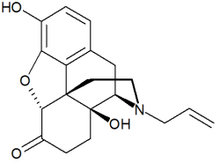Naloxone
Naloxone is a drug used to counter the effects of overdosing on opioids such as heroin and morphine. Specifically, naloxone is used in opioid overdoses for countering life-threatening depression of the central nervous system and respiratory system. It is marketed under trade names including Narcan, Nalone, and Narcanti. more...
The drug is derived from thebaine and has an extremely high affinity for μ-opioid receptors in the central nervous system. Naltrexone can be described as a substituted oxymorphone—here the tertiary amine methyl substituent is replaced with but-2-enyl. Naloxone is a μ-opioid receptor competitive antagonist, and its rapid blockade of those receptors often produces rapid onset of withdrawal symptoms. Naloxone also has an antagonist action, though with a lower affinity, at κ- and δ-opioid receptors.
Naloxone is injected, usually initially intravenously for fastest action. The drug acts after about two minutes, and its effects may last about 45 minutes. Naloxone has been distributed as part of emergency kits to heroin users, and has been shown to reduce rates of fatal overdose.
The drug also blocks the action of pain-lowering endorphins which the body produces naturally. The likely reason for this is that these endorphins operate on the same opioid receptors. In one experiment, women treated with naloxone reported higher pain levels during childbirth than women not so treated; in another experiment, the pain lowering effect of placebos was blocked if the placebos were administered along with naloxone.
While naloxone is still often used in emergency treatments for opioid overdose, its clinical use in the long-term treatment of opioid addiction is being increasingly superseded by naltrexone. Naltrexone is structurally similar but has a slightly increased affinity for κ-opioid receptors over naloxone, can be administered orally and has a longer duration of action.
The patent for Naloxone has expired and it is manufactured by various companies. The CAS number of naloxone is 465-65-6; the anhydrous hydrochloride salt has CAS 357-08-4 and the hydrochloride salt with 2 molecules of water has CAS 51481-60-8.
Naloxone has sometimes been mistakenly called "naltrexate."
Enteral naloxone has been successfully used in the reduction of gastritis and oesophagitis associated with opioid therapy in mechanically-ventilated acute care patients. (Meissner et al., 2004)
Read more at Wikipedia.org



